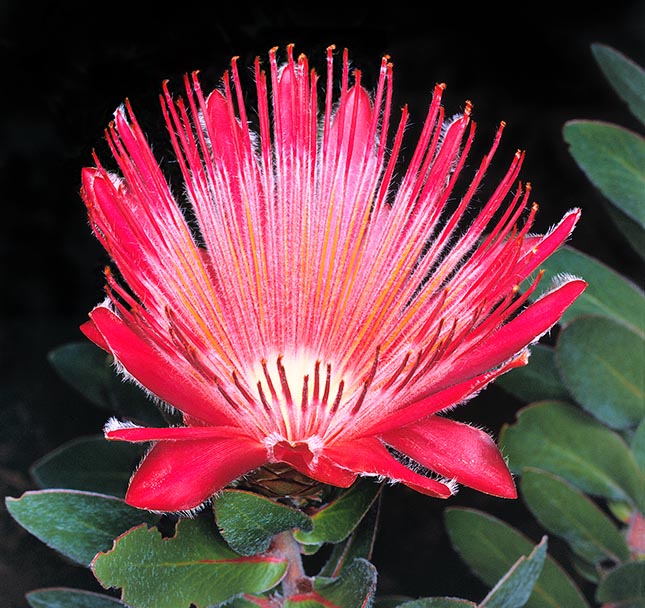Family : Proteaceae

Text © Pietro Puccio

English translation by Mario Beltramini

Protea aurea pyrotechnical inflorescences may reach 12 cm © Giuseppe Mazza
The name of the genus comes from “Proteus”, Greek mythological deity capable to assume any appearance wished, with reference to the diversity of the plants belonging to the genus; the name of the species is the Latin adjective “aureus, a, um” = golden, of unclear reference.
Common names: common shuttlecock sugarbush, long-bud sugarbush, shuttle- cock sugarbush (English); geel suikerbos, geel suikerkan, geelsuikerbos, geelsuiker- kan, lang suikerkan, langknop-suikerbos (Afrikaans).
The Protea aurea (Burm.f.) Rourke (1979) is a shrub or a small evergreen tree up to 5 m tall with alternate leaves from oblong to oval with lobed base, 4-9 cm long and up to 4 cm broad, morbid and velvety when young, then smooth and coriaceous, of grey-green colour.
Capitulum solitary terminal inflore- scences, conical, 9-12 cm long and of about 12 cm of diameter, enclosed by numerous imbricate bracts, coriaceous, villous at the margins, the inner ones being up to 9 cm long and 1,5 cm broad, of greenish cream to pink colour; the tiny flowers, with an 8,5-10,5 cm long style, are fertile at the centre, the outer ones are sterile and have the task of attracting the pollinators, birds in particular, which nourish of the abundantly produced nectar.
The fruit, which remains for long time on the plant, is an achene covered by a dense hair. It reproduces easily by seed in sandy, sterilized loam, acidic, at the temperature of 20-22 °C, with germination times of 3-6 weeks, or directly interred in autumn before the rains, with the first flowering usually taking place at the second year of age.
Fast-growing floriferous species, of easy cultivation and adaptable, and for these reasons is often present in the South African gardens, the only drawback being a generally rather short life.
It is cultivable in full sun preferably in the temperate climate zones of Mediterranean type, where, dry, can stand for short period temperatures up to about -4 °C, on deep soils, particularly draining, acidic or neutral. It bears fairly well the prunings, to be done after the flowering, in order to get a more compact and well tufted habit. It is also cultivable in capacious pots, with loams having the aforementioned characteristics.
It does not resist to the fire, having no lignotuber, the upper part of the root, enlarged and lignified, which allows the plant to regenerate after the fires, its survival is therefore entrusted to the seeds which are freed rightly in such circumstances. The inflorescences are long-lasting on the plant as well as when cut, and are therefore suitable for being utilized in the floral compositions.
→ Please look also the article about Protea
→ To appreciate the biodiversity within the family PROTEACEAE please click here.
